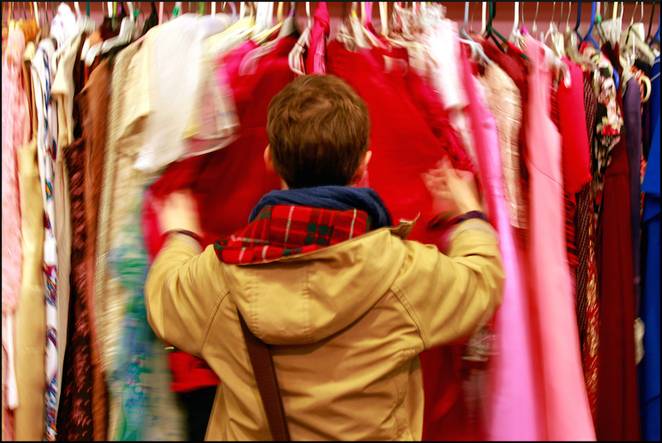
The fashion is supposedly the second most polluting industry in the world after oil. While these numbers are not verifiable (there is very little data available on the fashion industry’s global footprint), we do know how that the amount of resources required to produce clothes on the scale that they’re currently made is enormous.
According to the National Resources Defense Council, it takes 200 tons of water to make a ton of fabric – and much of that fabric doesn’t last long. Approximately 81 pounds of textiles are thrown away annually by every man, woman, and child in the United States. Cotton occupies only 2.4 percent of agricultural land but accounts for 24 percent of global sales of insecticides and 11 percent of pesticides.
Add to this the ‘fast fashion’ culture inundating our downtowns, shopping malls, billboards, and magazines – urging people to buy more at ever-cheaper prices – and clothing has become essentially disposable. No longer is it treated with care because it can be replaced quickly and cheaply.
This situation, according to Yale Environment 360, is set to change, as “pressure mounts to reform our throwaway clothing culture.” Textile recycling has become a hot topic, tossed around (very ironically) by fast-fashion giants H&M, Zara, and American Eagle Outfitters, among others. Some stores now accept old clothes for recycling, although this isn’t working as well as planned, as customers are less interested in hauling bags of old clothes to a store than taking home bags of new.
The Yale Environment 360 article outlines a number of great innovations being implemented by certain sections of the fashion industry, but most of these have yet to hit the mainstream. Change, in the meantime, needs to come from consumers. Our personal relationships with fashion must evolve if companies are ever going to prioritize reform.
So how does one do their part? This is how I approach it on a daily basis.
Stop buying so much.
You’d probably do fine with half the clothes in your closet. This is where Marie Kondo’s book “The Life-Changing Magic of Tidying Up” helped immensely, encouraging me to weed out the non-favorite items, which ended up being a surprising majority of my belongings. It has also made me pickier about what I buy.
Shop second-hand.
Second-hand clothes are the greenest ones you can find. By extending the life of a garment, in theory you save other resources from being tapped to create new items. Seek out local thrift stores (Goodwill, Value Village Community Donation Center, the Salvation Army, etc.), higher-end consignment stores like Plato’s Closet, and community rummage sales. Use the Internet to your advantage; there are countless websites likeThredUp (only in the United States), Kijiji, Craigslist, and VarageSale where you can buy or swap clothes, particularly for kids. If you live in Canada, the Canadian Diabetes Association will come pick up used clothes from your home through a program calledClothesline. Organize clothing swaps with friends.
Donate back to keep the cycle moving.
Value Village gives the following tips:
- Check your pockets before donating! Know that awesome feeling when you put on a winter coat and you find a $5 bill you didn’t remember was there? Unless you want a stranger to have that moment with your donations, make sure you check your pockets for any cash or belongings.
- Wrap it up! If you’re donating fragile items, make sure to wrap them in old newspapers. This prevents them from breaking, ensuring they will find a new owner to enjoy them.
- Nonprofits and thrift stores may take more than you think! For example, Value Village will find a way to reuse or recycle almost all of the clothing that comes through their Donation Center. Think those old, holey socks won’t cut it? Value Village will repurpose single socks and tattered clothing into rags for insulation.
- Band them together! When donating shoes, make sure to rubber band the pair together, so they stay a happy couple.
Wear it for a LONG time.
Fight back against the notion that fashion is disposable. View your purchases as investments, as deserving of care, as something you’ll want to wear for years. Avoid trendy fashions. Repair what you can. (I just took 10 pairs of my sons’ jeans to a local seamstress and had all the knees patched up for $70.)
Support interesting research.
Check out the work being done by Levi Strauss to incorporate post-consumer cotton garment waste into new jeans, as well as old fishing nets. A company called Nomadixwas scheduled to launch an entirely recycled cotton T-shirt, but unfortunately that campaign failed to raise sufficient funds, which is very unfortunate. The point is, research is happening, but it requires public support in order to become viable.
Buy organic if you can.
Organic cotton has a much smaller footprint than conventional. Learn more here. In her book “Spit That Out!” author Paige Wolf explains why we should prioritize organic whenever purchasing new clothing:
“The quality of organic cotton clothing is higher. Not exposed to harsh chemicals during the growing and harvesting process, organic cotton fibers are thicker, softer, and more durable. Durability and softness can actually save money in the long run, especially when you’re talking about well-worn items like sheets and blankets [and pajamas].”
Stop glamorizing fashion.
This will be an unpopular suggestion for all fashion lovers out there, but the industry, as it currently exists, is dirty and damaging. We need to talk about it honestly and openly, raise awareness through campaigns like Fashion Revolution’s #WhoMadeMyClothes, and discuss the implications of waste.
Who knows if the industry will change soon enough to make a difference to our planet — I’m not as optimistic as the Yale Environment 360 author — but I believe that each of us has a responsibility to do our part at home. What is your approach?
[Source:-TechHugger]






